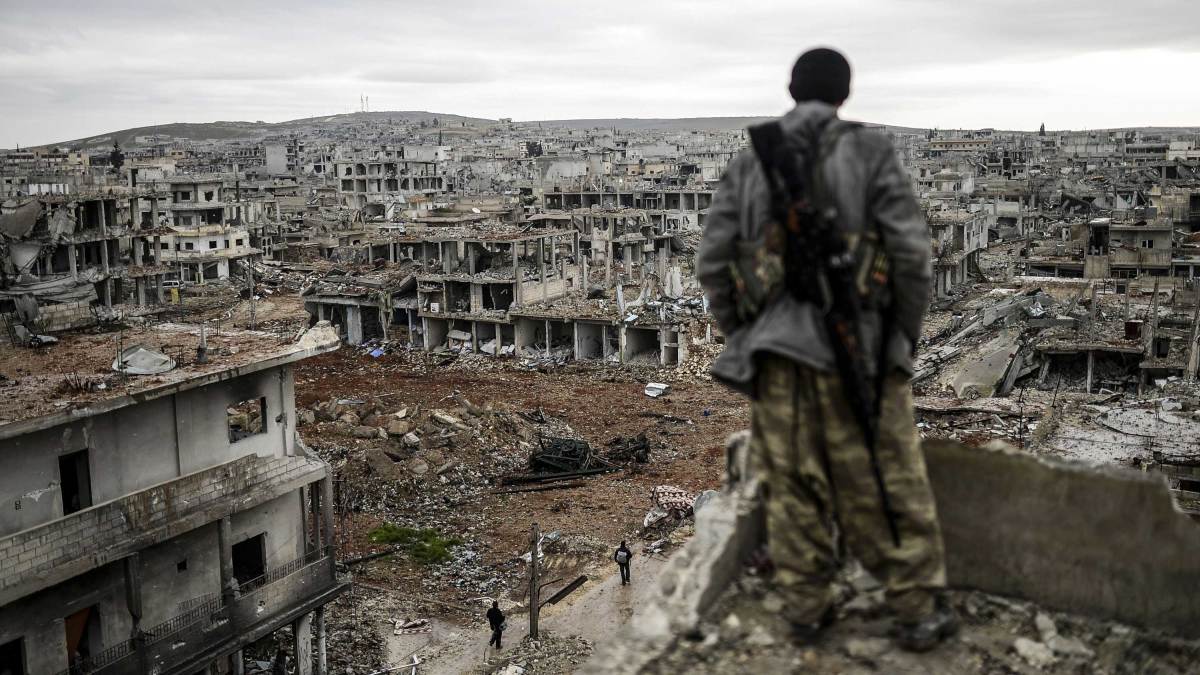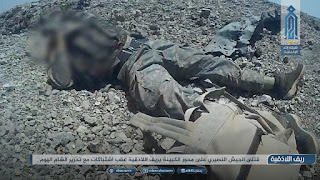Στελέχωση των τζιχαντιστικών ομάδων σε Συρία και Ιράκ από τους Αλβανούς.
Κατά τη διάρκεια του Συριακού εμφυλίου δεκάδες χιλιάδες μαχητές ανά τον κόσμο συνέδραμαν κάθε αντιμαχόμενη πλευρά. Οι περισσότεροι ξένοι μαχητές που κατατάσσονται στις οργανώσεις του Ισλαμικού Κράτους του Ιράκ και Λεβάντε (ISIL) και στις οργανώσεις που μάχονται ενάντια στη συριακή κυβέρνηση -Χαγιάτ Ταχρίρ αλ Σαμ (HTS), Αχράρ αλ Σαμ, κοκ- εμπνέονται και έλκονται κυρίως από θρησκευτικούς λόγους, τη τζιχαντ, αν και αρκετοί σημειώνουν ότι η θρησκεία δεν αποτελεί το μοναδικό κίνητρο. Από απλούς αρχάριους μέχρι σκληροπυρηνικούς μαχητές που αναζητούν τη μάχη και να γίνουν «μάρτυρες», άτομα που πηγαίνουν για ανθρωπιστικούς λόγους αλλά καταλήγουν να λαμβάνουν μετά ενεργά μέρος στη σύγκρουση, η πλήξη, η αναζήτηση μεγαλύτερης σημασίας στη ζωή, ο τυχοδιωκτισμός , οι προσδοκίες για αποκόμιση εμπειρίας από τις συγκρούσεις αποτελούν μερικούς από τους συνηθέστερους λόγους. (1) Όσον αφορά τον θρησκευτικό παράγοντα, η εξάπλωση των ριζοσπαστικών ισλαμικών κινημάτων στα Βαλκάνια δεν έγινε τυχαία: οργανώθηκε με την υποστήριξη και τη χρηματοδότηση εξτρεμιστικών κοινοτήτων από το Αφγανιστάν , την Αίγυπτο , το Ιράν και τη Σαουδική Αραβία . Σχεδόν όλοι οι διάσημοι ιεροκήρυκες του μαχητικού Ισλάμ στη χερσόνησο - Nejad Balkan , Bilal Bosnich , Nezim Khalilovich-Muderis , Nusret Imamovich , καθώς και οι Kosovar Zekeria Kazimi και Lulzima Kabashi συνελήφθησαν επειδή στρατολόγησαν άτομα, τα οποία με τη σειρά τους, επιστρέφοντας στην πατρίδα τους, άρχισαν να διαδίδουν ιδεολογία στις χώρες της πρώην Γιουγκοσλαβίας.
Μια από τις εκατοντάδες ομάδες στο αχανές μωσαϊκό του συριακού εμφυλίου είναι η Xhemati Alban, που σημαίνει «αλβανική ομάδα». Αυτή αποτελείται από άτομα αλβανικής καταγωγής από διάφορα σημεία της βαλκανικής χερσονήσου. Από το Κόσοβο, την Αλβανία, τα Σκόπια μέχρι και τη Σερβία στην κοιλάδα Πρέσεβο. Βασικές πηγές και άρθρα αποτελούν τα παρακάτω (2) και (3) με εκτενέστατη και λεπτομερή αναφορά. Από αυτά φαίνεται ότι η ομάδα αυτή έχει ενεργή δράση από το φθινόπωρο του 2017 όπου και αναρτήθηκε το πρώτο τους προπαγανδιστικό οπτικοακουστικό υλικό. Συμμετείχαν στα πεδία συγκρούσεων του δυτικού Χαλεπίου, του ΝΑ Ιντλίμπ και κυρίως της Λαττάκειας. Μέλη της έκαναν λόγο για συμμετοχή 3 έτη πριν, το 2014 (4) όπου η δραστηριότητα της οργάνωσης ήταν στη δυτική και βόρεια ύπαιθρο του Χαλεπίου. Ο επικεφαλής Abu Qatada al-Albani (Abdul Jashari) ασχολήθηκε στο να εκπαιδεύσει τους άνδρες του και είπε: «οι στρατιώτες εκπαιδεύτηκαν σε όλους τους τύπους μεσαίων και βαρέων όπλων, και δημιουργήθηκε επίσης μια ειδική ομάδα αλβανών ελεύθερων σκοπευτών (..). Τόνισε ότι η ιδεολογική προσέγγισή τους δεν διαφέρει από αυτήν της Hayat Tahrir al-Sham».
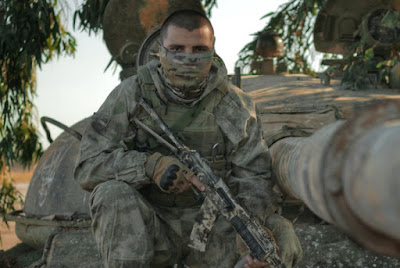 |
| Ο Abu Qatada al-Albani διατηρεί στενούς δεσμούς με τον Abu Muhammad al-Julani της HTS. |
Δεν υπάρχουν ακριβείς πληροφορίες για το σημείο στο οποίο ο ιδρυτής τζιχαντιστής αποφάσισε να συγκεντρώσει τους συμπατριώτες του σε αυτό το οργανωτικό πλαίσιο. Αλλά ήταν πιθανότατα το δεύτερο εξάμηνο του 2017, πριν αρχίσει να αναπτύσσεται η δραστηριότητα το 2018 . Όσο για τον ιδρυτή, ο Abu Qatada al-Albani είναι ένας από τους πιο επικίνδυνους και μυστηριώδεις τζιχαντιστές που δραστηριοποιούνται στη Συρία. Πριν έρθει , ο Abu Qatada ήταν κάτοικος της ΠΓΔΜ, στα μέσα της τέταρτης δεκαετίας της ζωής του. Σύμφωνα με τις ΗΠΑ, ο Abu Qatada είναι το ίδιο πρόσωπο που ονομάζεται Abdul Jashari, το οποίο εντασσόταν στις μαύρες λίστες στα τέλη του 2016, μαζί με τον Σαουδάραβα Αμπντουλάχ Αλ Αλ Μουχαϊσίνι, τον Συρο Αμπού Μαλίκ αλ Ταλί (Jamal Hassan Zainiya), και τον Ιορδανό Ashraf Ashraf Al-Alaq. Ο Abu Qatada έχει στενούς δεσμούς με τον Abu Muhammad al-Julani, και πολλές φορές έπαιξε καθοριστικό ρόλο στην καθιέρωση της επιρροής του τελευταίου πάνω στον επικεφαλής του Μετώπου Al-Nusra. Ένα από τα αξιοσημείωτα πλεονεκτήματα που απολαμβάνει ο Abu Qatada είναι ότι, μέχρι σήμερα, έχει γίνει αποδεκτός από τους περισσότερους τζιχαντιστές ηγέτες όλων των οργανώσεων.
Ο βασικός πυρήνας τους δραστηριοποιείται κυρίως πλέον στα όρη στο Καμπάνι στη βόρεια ύπαιθρο της Λαττάκειας. Η κύρια δραστηριότητα φαίνεται ότι αφορά τους ελεύθερους σκοπευτές και την παρακολούθηση αλλά η εκπαίδευση αφορά κάθε σχεδόν όπλο. Αρκετά αποσπάσματα προπαγάνδας που δημοσιεύθηκαν από την ομάδα δείχνουν ότι τα μέλη της διαθέτουν σημαντικές δυνατότητες . Φαίνεται να υπάρχει στον οπλισμό τους μια χρηματοδότηση, καθώς τα όπλα και ο εξοπλισμός τους είναι τυποποιημένα σε κάποιο βαθμό και η αναφερόμενη σε αρκετά μέσα καλή τους απόδοση ίσως επιβεβαιώνει τον σκοπό της «χορηγίας». Εμπειρογνώμονες πιστεύουν ότι είναι πιθανό ότι ορισμένα μέλη της ομάδας ήρθαν στον «κόσμο της τζιχάντ» από στρατιωτικό υπόβαθρο. Η σημερινή μάχιμή τους δύναμη κυμαίνεται ανάλογα με τις πηγές από 30 έως 70 άτομα ενώ μαζί με τις οικογένειές τους φθάνουν τα 200.
Αλβανοί μαχητές συμμετείχαν στον πόλεμο από τις αρχές του κιόλας όπως ο Lavdrim Muhaxheri, που βρέθηκε στις γραμμές μιας «συγγενικής» ομάδας της Αλ Νούσρα, σήμερα HTS. Ο συγκεκριμένος είχε ενδιαφέρουσα πορεία ξεκινώντας αρχικά ως στέλεχος της Δύναμης Κοσόβου και του ΝΑΤΟ, για να βρεθεί το 2012 στη Συρία, στις τάξεις της Αλ Νούσρα η οποία ακόμα ήταν μέρος της Αλ Κάιντα. Το επόμενο έτος εισέρχεται ξανά στην Ευρώπη με άγνωστο δρομολόγιο και φθάνει στο Κόσοβο, όπου ταυτοποιείται σε ραμαζάνι με την Ισλαμική Κοινότητα Κοσόβου. Ξαναγυρνάει στο πεδίο της μάχης αλλά αυτή τη φορά με μια ομάδα ομοεθνών του από διάφορα μέρη (Κόσοβο, Σκόπια) εντεταγμένος πλέον στο Ισλαμικό Κράτος. Τα καλέσματά του προς τους συμπατριώτες του σίγουρα είχαν κάποια απήχηση και προσέλκυσαν μερικούς από τους 500 περίπου συνολικά Αλβανούς με μ.ο. ηλικίας τα 30 έτη, που από το 2012 είχαν μεταφερθεί στη Συρία και το Ιράκ , εντασσόμενοι κυρίως στο Ισλαμικό Κράτος και στην Αλ Νούσρα. Τα παραπάνω στοιχεία δείχνουν ότι σε σχέση με τον πληθυσμό του 1,8 εκατομμυρίων, το Κόσοβο είναι αναμφισβήτητα η μεγαλύτερη πηγή ευρωπαίων τζιχαντιστών στη Συρία και το Ιράκ. Με ποσοστό άνω των 16 μαχητών ανά 100.000 υπηκόους, το ποσοστό πρόσληψης του Κοσσυφοπεδίου είναι περισσότερο από οκτώ φορές εκείνο της Γαλλίας, της μεγαλύτερης συνολικής πηγής τζιχαντιστών της Ευρώπης στη Συρία και το Ιράκ, όπου και εκείνοι είναι κατά συντριπτική πλειοψηφία μουσουλμάνοι νεότερων γενεών.
Φαίνεται αξιοσημείωτο ότι αρκετές πηγές έχουν επιβεβαιώσει ότι αρκετοί Αλβανοί τζιχαντιστές που πολεμούσαν στο ISIL προσχώρησαν μετέπειτα στην αμιγώς αλβανική οργάνωση. Χωρίς την προσδοκία κάποιου είδους συμφιλίωσης μεταξύ του Al-Julani και του νεκρού σήμερα ηγέτη του IΚΙΛ Abu Bakr Al-Baghdadi, πολλά στοιχεία δείχνουν ότι αυτό ήταν μια ανεπίσημη αδήλωτη ανακωχή μεταξύ των δύο πλευρών.
Αλβανική ισλαμική τρομοκρατία στην Ευρώπη.
Ένας από τους λόγους που οι Αλβανοί , και ιδιαίτερα αυτοί του Κοσόβου, επιστρέφουν στην πατρίδα τους, είναι οι εξαιρετικά χαμηλές ποινές που αντιμετωπίζουν. Παράδειγμα αποτελεί ο Fitim Lladrovci ο οποίος πολέμησε στη Συρία στο πλευρό του ΙΚΙΛ, επέστρεψε το 2015, εξέτισε δύο χρόνια στη φυλακή και στη συνέχεια βγήκε ως «ήρωας» και κάλεσε τους κατοίκους να ακολουθήσουν παράδειγμά του και ανέφερε δημοσίως ότι επιθυμεί τη σύσταση Ισλαμικού Κράτους στο Κόσοβο.
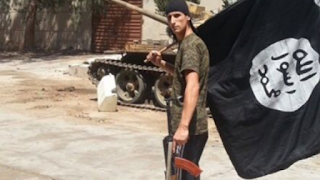 |
| O Fitim Lladrovci με σημαία του ΙΚΙΛ. |
Το 2014 εννέα άτομα, συμπεριλαμβανομένων δύο ιμάμηδων, συνελήφθησαν επειδή είχαν στρατολογήσει και χρηματοδοτήσει την αποστολή 70 εθελοντών στη Συρία και το Ιράκ, σε τζιχαντιστικές ομάδες.
Στις 24 Απριλίου 2019 ο Bledar Ibrahimi συνελήφθη στην Αλβανική πόλη Ελμπασάν. Συμφωνα με τις κρατικές αναφορές θεωρείται «επικίνδυνο πρόσωπο για τη δημόσια ασφάλεια στην Ιταλία και υπάρχει υποψία ότι εμπλέκεται σε τρομοκρατικές δραστηριότητες στην Ιταλία και την Αίγυπτο». Η σύλληψη πραγματοποιήθηκε μετά από διεθνές ένταλμα σύλληψης που εκδόθηκε τον Μάρτιο από ιταλό εισαγγελέα «για συμμετοχή σε τρομοκρατική οργάνωση». Ο Ibrahimi είχε ήδη απελαθει από την Ιταλία το 2016 και οι πληροφορίες αναφέρουν για ύποπτους δεσμούς με μαχητές του Ισλαμικού Κράτους.
Στις 17 Νοεμβρίου 2016 πραγματοποιείται μια μεγάλη επιχείρηση στο Κόσοβο, την Αλβανία και τα Σκόπια. Η αστυνομία αναφέρει τη σύλληψη 19 ατόμων και ότι έχουν αποτρέψει ταυτόχρονες επιθέσεις που σχεδίαζαν στο όνομα του Ισλαμικού Κράτους στο Κόσοβο και τη γειτονική Αλβανία, συμπεριλαμβανομένης μιας προγραμματισμένης επίθεσης κατά της ισραηλινής εθνικής ομάδας ποδοσφαίρου κατά τη διάρκεια ενός αγώνα. Οι συλληφθέντες έλαβαν εντολές από τον ίδιο τον Lavdrim Muhaxheri, τον αυτοαποκαλούμενο «διοικητή των Αλβανών στη Συρία και το Ιράκ», δήλωσε η αστυνομία. Στα σπίτια και τους χώρους των υπόπτων βρήκαν εκρηκτικές συσκευές, όπλα και ηλεκτρονικός εξοπλισμός, συμπεριλαμβανομένου «θρησκευτικού υλικού και βιβλιογραφίας από γνωστούς συγγραφείς αναγνωρισμένους για την εξτρεμιστική τους ιδεολογία».Οι ομάδες των τριών χωρών, συντονισμένες από δύο Αλβανούς που αποτελούν μέρος της τρομοκρατικής οργάνωσης του Ισλαμικού Κράτους στη Συρία, είχαν «σαφείς στόχους» για το ποιος πρέπει να επιτεθεί και πότε. Στις 7 Δεκεμβρίου του ίδιου έτους οι βελγικές αρχές συνέλαβαν ομάδα 8 ατόμων που διατηρούσε σχέση με το Ισλαμικό Κράτος και στρατολογούσε άτομα, εκ των οποίων οι 2 ήταν Αλβανοί από το Κόσοβο. Να σημειωθεί ότι το Βέλγιο είναι η χώρα με το μεγαλύτερο ποσοστό εθελοντών στο Ισλαμικό Κράτος ανά κάτοικο, με συνολικό επίσημο αριθμό τους 465.
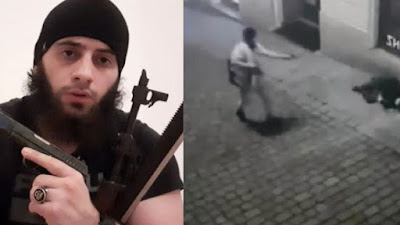 |
| O Kujtim Fejzullai σε ανάρτησή του στα μέσα κοινωνικής δικτύωσης λίγο πριν από την επίθεση και δεξιά κατά τη διάρκεια αυτής. |
Τον Νοέμβριο του 2020 και συγκεκριμένα στις 2 του μηνός, στην πόλη της Βιέννης στην Αυστρία ξεσπάει ένοπλη τρομοκρατική επίθεση του Αλβανού στην καταγωγή Kujtim Fejzullai. Ο επιτιθέμενος ήταν οπλισμένος με ένα τυφέκιο ΑΚ, ένα πιστόλι και ένα μεγάλο μαχαίρι ενώ έφερε πάνω του και μια ψεύτικη ζώνη αυτοκτονίας με υποτιθέμενα εκρηκτικά. Συνολικά ο ισλαμιστής σκότωσε 4 άτομα και τραυμάτισε άλλα 23, μεταξύ των οποίων και ένας αστυνομικός, πριν πέσει τελικά νεκρός από τις δυνάμεις της μονάδας Wega.
Στις 27 Δεκεμβρίου 2020 η αστυνομία των Σκοπίων προβαίνει στη σύλληψη 8 ανδρών οι οποίοι σχεδιάζαν τρομοκρατικές επιθέσεις υπέρ του ΙΚΙΛ, όπως επισήμως ανέφερε και το υπουργείο Εσωτερικών . Ένας από τους συλληφθέντες της είχε προηγούμενη καταδίκη για συμμετοχή σε ενέργειες του ΙΚΙΛ. Οι οκτώ συνελήφθησαν στην πόλη των Σκοπίων και στο Κουμάνοβο μετά από μια μακροχρόνια έρευνα.
Στην άλλη μεριά της Αδριατικής, στις 21 Απριλίου 2021 η ιταλική αστυνομία συνέλαβε έναν 28χρονο Αλβανό, τον Endri Elenzi, καταζητούμενο σε σχέση με την επίθεση φορτηγών της Νίκαιας το 2016.Ο ύποπτος πιστεύεται ότι είναι συνεργός του επιτιθέμενου, Mohamed Lahouaiej Bouhlel, ο οποίος προκάλεσε τότε σφαγή, σκοτώνοντας 86 άτομα με την τρομοκρατική επίθεση στη γαλλική πόλη. Ο άνδρας καταζητήθηκε με ευρωπαϊκό ένταλμα σύλληψης που εκδόθηκε από γαλλικές αρχές για φερόμενη προμήθεια όπλων στον Bouhlel. Συνελήφθη από την ιταλική αστυνομία στην πόλη Σπαρανίσε, περίπου 40 χιλιόμετρα βόρεια της Νάπολης.
Πηγές
-https://silahreport.com/2021/03/27/albanians-fighting-in-syria-xhemati-alban-in-2020-part-1/
-https://www.huffingtonpost.co.uk/rachel-briggs/foreign-fighters-how-to-win-war-of-ideas_b_5295531.html
-https://www.calibreobscura.com/the-xhemati-alban-sniper-squad-and-weapons/
-https://www.alquds.co.uk/%D9%83%D8%AA%D9%8A%D8%A8%D8%A9-%D8%A3%D9%84%D8%A8%D8%A7%D9%86%D9%8A%D8%A9-%D8%A3%D8%AD%D8%A8%D8%B7%D8%AA-%D9%85%D8%A6%D8%A7%D8%AA-%D8%A7%D9%84%D9%87%D8%AC%D9%85%D8%A7%D8%AA-%D8%A8%D8%B1%D9%8A/
-https://al-akhbar.com/Syria/276826
-https://ctc.usma.edu/ethnic-albanian-foreign-fighters-in-iraq-and-syria/
-https://news.myseldon.com/ru/news/index/237340197
- Ειδησεογραφικά δελτία από τις επιχειρήσεις με τις συλλήψεις από το 2014 έως το 2021.
